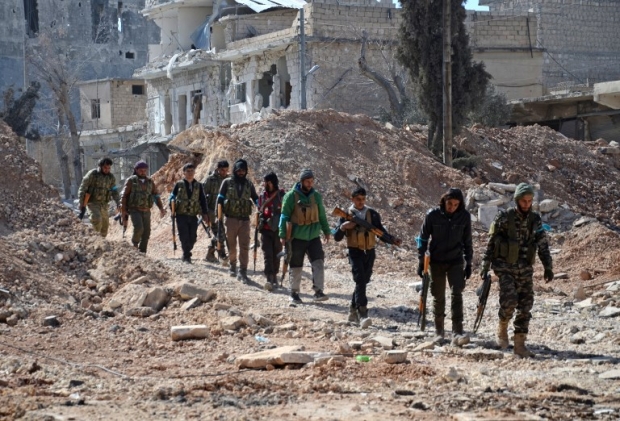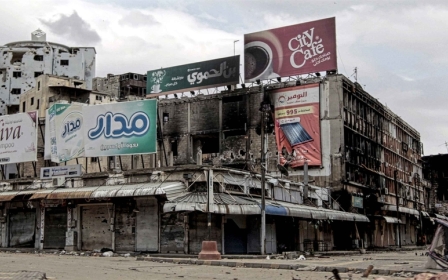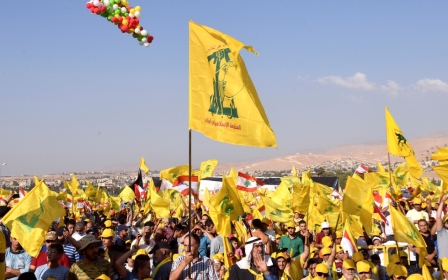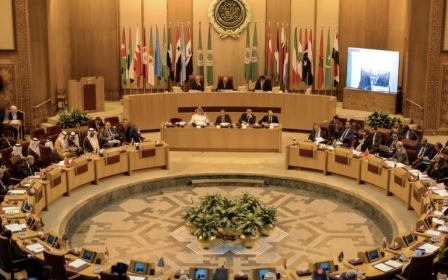Iran’s Syria policy post-IS: Staying for the long haul

On 20 October, Iran's military chief of staff General Mohammad Baqeri paid a rare visit to a frontline position near the northwestern Syrian city of Aleppo. During the tour, he met with a group of what has come to be known as "shrine defenders", the paramilitary forces Tehran has mobilised in the course of the Syrian civil war to fight for the Syrian government and thus protect Syria's Shia holy sites, including the Sayyida Zaynab shrine in Damascus.
Securing the "axis of resistance" - running from Iran through Iraq and Syria to Lebanon - was the raison d'etre of the Islamic Republic's costly intervention in the conflict
Coordination between the shrine defenders and the Syrian army has been the "key to victory" in the almost seven-year-long conflict, he said, stressing that such cooperation should continue "for a long period of time" in the future.
A multi-faceted strategy
In a meeting with the Syrian President Bashar al-Assad himself a day earlier, General Baqeri had declared Iran's determination to maintain a "joint strategy in military coordination and cooperation" with Syria "after terrorism is uprooted".
In fact, Iran is pursuing a multi-faceted strategy in Syria in the long haul, of which securing reliable access from Iraq to Lebanon - where Hezbollah lies - is an integral part. Equally significant is the Iranian leadership's desire to establish a firm foothold in southwestern Syria, to the east of Israeli-occupied Golan Heights.
Tehran also seeks to guarantee Syria's territorial integrity under the current Syrian leadership by preventing Kurds or other ethnic and sectarian groups from carving out a state of their own in the post-Islamic State (IS) climate.
And finally, the Islamic Republic has shown a keen interest in arrangements for the reconstruction of Syria and in reaping its potential dividends.
Almost seven years into the Syrian civil war, it is no secret that Tehran has gone to great lengths to maintain uninterrupted land access to Lebanon, which it has traditionally used to supply Hezbollah with arms and goods.
Securing the "axis of resistance" - running from Iran through Iraq and Syria to Lebanon - was in fact the raison d'etre of the Islamic Republic's costly intervention in the conflict.
In a speech last August, Kamal Kharrazi, head of Iran's strategic council of foreign relations, stressed that the Islamic Republic takes pride in supporting resistance forces in the region, particularly the Lebanese Hezbollah.
According to Iran's supreme leader, Ali Khameni, it was the preservation of Iran’s "strategic depth" in the Middle East that drove its unprecedented military involvement in this "foreign" war in the first place. "If we had not fought in Damascus, we had to fight in Tehran," Khameni said.
A revisionist state
The Iranian leadership has often claimed that terrorism needed to be nipped in the bud, but as I have argued on these pages before, if Iranian leaders were genuinely worried about terrorist threats, they would refrain from pursuing policies that generate and foster terrorism in the first place.
This includes the sustained support for the former Iraqi prime minister, Nouri al-Maliki, whose extremely sectarian manner of governance played a significant role in the rise of IS.
Helping sustain the Syrian government as Iran's sole strategic ally in the Middle East and an indispensable component of the "axis of resistance" has cost the Islamic Republic dearly
Moreover, as a "revisionist" state and thus strategically "lonely", the Islamic Republic seems to believe that its abandonment of the Syrian president would have sent dangerous and destabilising signals of disloyalty to the whole constellation of non-state actors and proxies under its tutelage and therefore cast Tehran as an unreliable patron.
However, helping sustain the Syrian government as Iran's sole strategic ally in the Middle East and a presumably indispensable component of the "axis of resistance" has cost the Islamic Republic dearly.
According to Mohammad Ali Shahidi, the head of Iran’s Martyr Foundation, over the past six years since the outbreak of the Syrian war in early 2011, at least 2,100 "shrine defenders" have been killed.
Also as sources close to Staffan de Mistura, the UN special envoy for Syria, have pointed out, Iran is estimated to be spending $6bn a year on supporting the Syrian government. Other estimates have put the expenditure, in terms of military and economic aid, between $15 and $20bn annually.
Determined to take the battle as close to enemy territory as possible, Iran has been seeking over the past year to strengthen its military presence in southwestern Syria, where it can open up a new front against Israel in case of military confrontation between the two archfoes.
According to recent reports, Iran is believed to be building a permanent military base near Damascus, which will afford it greater control over the Golan region. It has also been known to fly reconnaissance drones in the Golan Heights and the area bordering Israeli territory.
Preventing a Kurdish state in Syria
Iran's other strategic objective is to deny ethnic or minority groups, particularly Kurds in northeast Syria, the chance to form an independent state of their own.
While precluding Kurdish independence in Iraq was of greater strategic significance to Tehran - as the swift recapture of Kirkuk from Peshmerga forces with the assistance of Iran-backed Iraqi Popular Mobilisation Units (PMU) clearly demonstrated - Iranian leaders are also concerned about such a possibility in Syria.
As long as Syrian Kurds are heavily supported by Washington, it is hard to imagine how Damascus will recover territories under Kurdish control at the moment
Sustained battlefield victories against IS by the US-backed Syrian Democratic Forces (SDF), which consists mostly of Kurds, seems to have fuelled these worries.
The threat perception is also shared by Turkey and helps explain growing political and military cooperation between Tehran and Ankara in Iraq as well as in Syria recently.
The Syrian government's public objections notwithstanding, the deployment of Turkish military forces in Idlib - with the purpose of establishing “de-escalation zones” - and plans to expand the operation to Afrin further north would not be as smoothly possible without Russian-Iranian blessing.
Nonetheless, as long as Syrian Kurds are heavily supported by Washington, it is hard to imagine how Damascus will recover territories under Kurdish control at the moment.
While the minutes of Baqeri's 19 October meeting with Assad have not been publicised, it seems the Iranian top commander has reassured Damascus about Turkish military manoeuvres in the northwest.
Reconstructing war-torn Syria
Last but not least, Iran has been preparing, in conjunction with Russia, to play an active role in the reconstruction of Syria.
To this end, five memoranda of understanding were signed between the two regional allies during a visit by Syrian Prime Minister Emad Khamis to Tehran in January 2017, including contracts for mining phosphate, supplying mobile operation services, and installing oil and gas terminals.
Given that the Islamic Revolutionary Guards Corps (IRGC) controls the bulk of telecommunications industry in Iran, it is expected to particularly benefit from the mobile network deal in Syria as well, which will also enable the group to keep a close tab on Syrian communications.
While some opposition figures have condemned such arrangements as the "looting" of Syria's national wealth, Tehran looks poised to harvest what it has sown regardless.
As Baqeri has explicitly stated, Iran is in Syria to stay for the long haul.
- Maysam Behravesh is a PhD candidate in the Department of Political Science and a Research Fellow in the Center for Middle Eastern Studies (CMES), Lund University. He was a senior editor of the Wiley-published journal Asian Politics & Policy and editorial assistant of the Sage-published quarterly Cooperation and Conflict. Maysam is also a regular contributor to Persian-language media outlets including BBC Persian.
The views expressed in this article belong to the author and do not necessarily reflect the editorial policy of Middle East Eye.
Photo: Iranians mourn during the funeral of the victims of the attacks on Tehran's parliament complex and the shrine of revolutionary leader Ayatollah Ruhollah Khomeini, in the capital Tehran on June 9, 2017. Tehran hit out at Washington and Riyadh as tens of thousands attended the funerals Friday for those slain in the first attacks in Iran claimed by the Islamic State group. (AFP)
New MEE newsletter: Jerusalem Dispatch
Sign up to get the latest insights and analysis on Israel-Palestine, alongside Turkey Unpacked and other MEE newsletters
Middle East Eye delivers independent and unrivalled coverage and analysis of the Middle East, North Africa and beyond. To learn more about republishing this content and the associated fees, please fill out this form. More about MEE can be found here.







